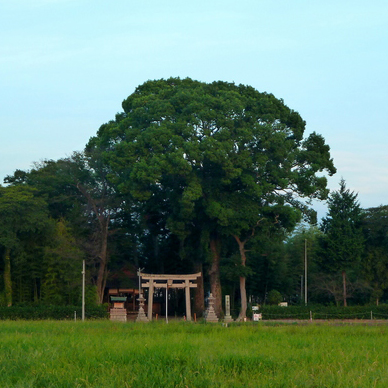Chinju-no-mori

Have you ever traveled in Japan by shinkansen? You can see a cluster of trees looking like a small green island amidst the rice paddies from the shinkansen window. That is a chinju-no-mori. A Chinju-no-mori is a small forest surrounding a Shinto shrine. Similar landscapes can be commonly found in Japanese rice-producing areas.
When you see a shrine from a distance, you can recognize a dense forest – chinju-no-mori – and a torii gate (shrine gate) at one end. Passing through the torii gate and walking along the approach, there is the shrine building surrounded by the forest. Visitors pray toward the forest. This structure suggests that forests existed first and many of the shrines were built there later. This fact is deeply linked with the worshiping of nature in Japan. Natural features such as awe-inspiring forests, mountains (e.g. Mt. Fuji), and gigantic stones have been religious objects since before the introduction of Buddism. So Chinju-no-mori have long been religious objects in Japan.
Also, chinju-no-mori have been places for interexchange and recreation where shrine rituals, festivals and annual events are held. Chinju-no-mori have existed in Japanese rural communities as “Chinju-sama,” both as objects of worship and as forests closely connected with our everyday life
There were a lot of chinju-no-mori in respective villages; however, a number of shrines and forests were destroyed according to a Shrine Merger Policy in 1906. Kumagusu Minakata (1867-1941, naturalist, biologist, and folklorist) worried about this large-scale nature destruction, and commenced a nature conservation campaign along with the movement against shrine merger. A variety of unknown mosses and slime molds existed in chinju-no-mori and they would be threatened once the forests were logged.
“In god forests where nobody has logged for more than 1000 years, the interrelationships among diverse organisms are closely linked. Recently, this linkage has begun to be studied in the name of ecology.” (Translation of Minakata’s letter to Kawamura, the governor of Wakayama Prefecture, Japan, November 19, 1911)
Minakata used the English word “ecology” for the first time in Japan, and explained that all organisms live in the linkage of lives. As such, he stressed the conservation of chinju-no-mori from the ecological perspective. Also from the ethnological perspective, he insisted that religious faith, culture and tradition would be destroyed by the deforestation of chinju-no-mori. As his enthusiastic appeal moved public opinion, shrine mergers ceased to be promoted after the House of Peers resolved that “shrine mergers are unnecessary.” Chinju-no-mori were able to escape deforestation.
As chinju-no-mori have been conserved in this way, their vegetation can be considered as remaining original vegetation in the region. Nowadays, most of the nature environments around chinju-no-mori have been further developed; this can provide a clue for studying the original natural environment in the region. Therefore, chinju-no-mori have been greatly valued in the field of silvics in Japan.
However, familiarity and reverence toward chinju-no-mori have weakened since 1950s, and their number was drastically decreased by the land development during the high-growth period of the Japanese economy (1950s-1970s). Such variation of the environment would have different influences on both flora and fauna.
With their long history, chinju-no-mori remain a key element in the relationship between Japan’s inhabitants and nature.
(Rieko Tanimoto)










